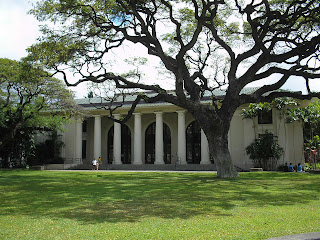The
earliest libraries in Hawaiʻi appear to have been reading rooms provided for
ships officers and crews. In Lāhainā, the
Seamen's Chapel and Reading Room was built in 1834 following an appeal by
William Richards and Ephriam Spaulding (it was built two years later.)
In
Honolulu, the Sandwich Islands Institute, organized in November 1837, fitted up
a room at the Seamen's Bethel in downtown Honolulu as a library and a museum of
natural history and Pacific artifacts.
A
newspaper article in October 1840 referred to this as a "Public Library,
three to four hundred volumes" and also listed a "Reading Room for
Seamen," presumably at a different location.
A decade
later, in 1850, residents of Honolulu organized the Atheneum Society, which for
a year or two maintained a reading room and library. The Atheneum was succeeded
in 1853 by the Honolulu Circulating Library Association.
In 1879,
a group of men founded the Honolulu Library and Reading Room Association. In the local newspaper, the Commercial Pacific
Advertiser, editor JH Black wrote, "The library is not intended to be run
for the benefit of any class, party, nationality, or sect."
Some of
the founders wanted to exclude women from membership, but Alexander Cartwright
disagreed, writing to his brother Alfred: "The idea keeps the blessed
ladies out and the children. What makes
us old geezers think we are the only ones to be spiritually and morally
uplifted by a public library in this city?"
It
wasn't long before the committee changed the wording of the constitution to
make women eligible for membership.
Early in its history, the organization had
established a solid economic foundation, and over time it was able to obtain
the moral and financial support of both the Hawaiian government and wealthy
citizens.
King Kalākaua,
Queen Kapiʻolani, Queen Emma, Princess Bernice Pauahi Bishop, Regent
Lili‘uokalani, Minister of the Interior F. W. Hutchinson and Charles R. Bishop
were just a few of its notable and highly influential supporters.
From
1879 to 1912, library service was provided by the Honolulu Library and
Reading-Room Association.
In 1909,
Governor Frear helped pass the “Act to Provide for the Establishment of the
Public Library of Hawaii”. On May 15, 1909
the Honolulu Library and Reading Room and the Library of Hawaiʻi signed an
agreement by which the former agreed to turn over all books, furnishings and remaining
funds to the latter.
A few
months later, the Honolulu Library and Reading Room, Library of Hawaiʻi and the
Historical Society jointly signed and submitted a letter to Andrew Carnegie
requesting a grant for the construction of the Library of Hawaiʻi.
The
request to Carnegie was for funds to build the new Library; Carnegie responded
that the sum of $100,000 would be made ready as soon as a site was selected and
plans drawn up.
The
building's final location, though, was not immediately settled. Several possible sites were considered. Ultimately, Governor Frear made a lot
available on the corner of King and Punchbowl streets.
He
picked a site that in 1872 had been purchased by the Government of Prince
Lunalilo and transferred its control to the Board of Education. In 1874, the government-supported Pohukaina
School for Girls was started. Just up
the street was the Royal School for Boys.
In order
to accommodate the new Library of Hawaiʻi, after 36-years at King and
Punchbowl, Pohukaina School was moved to Kakaʻako; the new school opened in
1913.
Ultimately,
the Library of Hawaiʻi was completed at a cost of $127,000, with the local
legislative funding providing the difference.
The
building opened its doors on February 1, 1913, and Hawaiʻi at last joined those
states of America that offered free library services to their communities. The library, now known as the Hawaiʻi State
Library, still stands today.
Greco-Romanesque
columns in front mark it as a Carnegie library, and within its lobby, a bust of
Andrew Carnegie, the man who made it possible is on the grounds.
In 1921,
the County Library Law established separate libraries on the islands of Kauaʻi,
Maui and Hawaiʻi, under minimal supervision by the Library of Hawaiʻi, which
restricted its services to Oʻahu. Even
so, the latter quickly outgrew its quarters.
In 1927,
the Territorial legislature approved funding to expand and renovate the
building. Construction was completed in 1930. Architect CW Dickey tripled its
size by adding new wings to create an open-air courtyard in the center.
After
statehood in 1959, the Hawaiʻi State Legislature created the Hawaiʻi State
Public Library System, the only statewide system in the United States, with the
Hawaiʻi State Library building as its flagship branch.
My
grandmother worked at the State Library, from 1920 to 1948; she retired after
serving as Assistant Head Librarian and Director of the Extension Department. Part of her duties included the expansion of
the Library to the Neighbor Islands in 1921.
My
mother received a degree in Library Science and was archivist at Punahou
School; my younger sister just started a job in the Library of her children’s
school in Montana. (Seems like
Librarians are in the family.)
I have
included other images of library facilities noted here in a folder of like name
in the Photos section on my Facebook page.
© 2012
Hoʻokuleana LLC

No comments:
Post a Comment